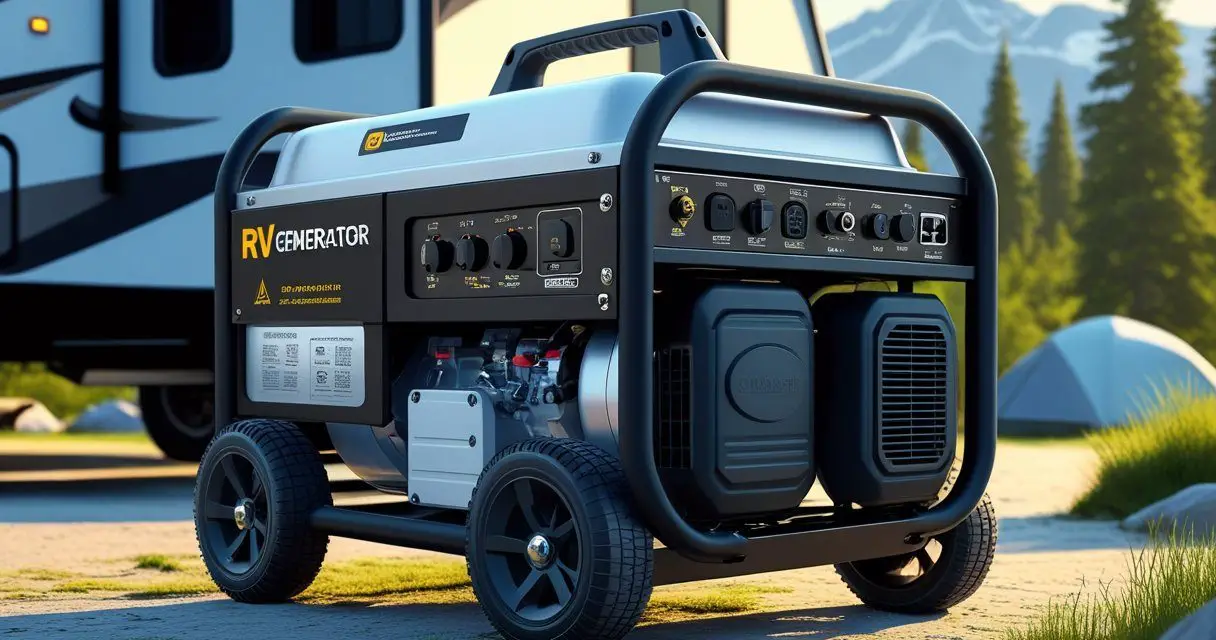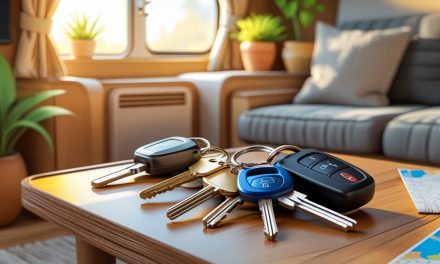Would you like to save this article?
Running your RV generator while driving is not only possible – it’s actually recommended by many RV manufacturers! But before you hit the road with your generator humming, there are important safety rules, legal considerations, and best practices you absolutely need to know.
This complete guide answers the most common question RV owners ask: “Can my RV generator run while driving?” We’ll cover everything from safety tips to fuel costs, so you can travel comfortably and confidently.
The Short Answer: Yes, But Only Built-In Generators
✅ YES – You can run a built-in RV generator while driving
❌ NO – You should NOT run portable generators while driving
Watch: Expert advice on running RV generators while traveling
The key difference is safety and design. Built-in generators are specifically engineered for use during travel, while portable units create serious safety risks when used on the road.
Why Would You Want to Run Your Generator While Driving?
1. Keep Everyone Cool and Comfortable
Your dashboard air conditioning can’t cool your entire RV effectively. It’s designed for the cab area only. Running your generator powers the rooftop air conditioning unit, which keeps the entire living space comfortable for passengers.
This is especially important during hot summer travel when temperatures inside an RV can quickly become dangerous.
Watch: Running RV air conditioning efficiently while driving
2. Charge Your House Batteries Faster
While your vehicle’s alternator does charge the house batteries, it has many other jobs too. Running the generator provides dedicated charging power that gets your batteries to full capacity much quicker.
Pro Tip: This is particularly effective with lithium batteries, which charge faster than traditional lead-acid batteries.
3. Power Essential Appliances
Running your generator while driving allows you to use:
- Refrigerator (keeps food cold on long trips)
- Microwave (for passenger snacks and meals)
- Television (entertainment for passengers)
- Electric water heater (hot water ready when you arrive)
- 110-volt outlets (charging devices, running small appliances)
Built-In vs. Portable Generators: What’s the Difference?
| Feature | Built-In Generators | Portable Generators |
|---|---|---|
| Safe While Driving? | ✅ Yes | ❌ No |
| Properly Ventilated? | ✅ Yes | ❌ Risk of carbon monoxide |
| Secure Mounting? | ✅ Yes | ❌ Movement and vibration issues |
| Easy Monitoring? | ✅ Dashboard controls | ❌ Hard to monitor while driving |
| Professional Installation? | ✅ Yes | ❌ DIY mounting risks |
Why Portable Generators Are Dangerous While Driving
Never run a portable generator while driving because:
- Carbon monoxide poisoning risk from poor ventilation
- Fire hazard from overheating in enclosed spaces
- Electrical connection problems from road vibration
- No emergency shutdown capability from the driver’s seat
Step-by-Step Guide: How to Safely Run Your Generator While Driving
Before You Start:
1. Check Your Fuel Level
- Ensure you have enough fuel for both driving and generator operation
- Remember: Your generator uses the same fuel tank as your RV engine
- Plan for reduced fuel economy (typically 10-20% decrease)
2. Perform a Safety Inspection
- Look for any oil leaks or loose connections
- Clear any debris from the generator compartment
- Check that air vents are unobstructed
Starting Procedure:
Step 1: Start the generator and let it warm up for 2-3 minutes
Step 2: Once at full power, start your RV engine
Step 3: Turn on desired appliances (air conditioning, etc.)
Step 4: Monitor generator performance during travel
While Driving:
- Watch your fuel gauge more closely
- Listen for unusual sounds from the generator
- Check generator status on your dashboard display
- Turn off generator before refueling
Watch: Generator tips specifically for Class C motorhomes
Fuel Consumption: What to Expect
Real-World Fuel Usage Data
Based on owner reports and manufacturer specifications:
| Generator Size | Fuel Usage per Hour | Impact on MPG |
|---|---|---|
| 4,000W (Onan 4000) | 0.25 – 0.5 gallons | 10-15% decrease |
| 5,500W (Onan 5500) | 0.33 – 0.75 gallons | 15-20% decrease |
| 8,000W (Onan 8000) | 0.5 – 1.0 gallons | 20-25% decrease |
Example Calculation:
If your RV normally gets 10 MPG and you run a 5,500W generator:
- Without generator: 10 gallons per 100 miles
- With generator: 12 gallons per 100 miles
- Extra cost: About $7-10 per 100 miles (at $3.50/gallon)
Most RV owners agree: The comfort and convenience are worth the extra fuel cost.
Watch: How long can you run an RV generator continuously
Legal Considerations: Know the Rules
Propane-Powered Generators
If your generator runs on propane instead of gasoline/diesel, you need to check local laws:
States with Propane Restrictions:
- Some highways, bridges, and tunnels prohibit propane use while driving
- Gas stations typically require all propane appliances to be turned off
- Ferry boats often have strict propane policies
Safety Tip: Research your travel route ahead of time and know where propane restrictions apply.
Watch: Critical propane driving safety tips for RVers
California’s New Generator Regulations
Starting in 2024, California has new emissions requirements that affect:
- New RV sales with built-in generators
- Portable generator sales
- Generator service and parts
This doesn’t affect existing RVs or your ability to travel through California with your current generator.
Safety First: Essential Precautions
Before Each Trip:
✅ Maintenance Checklist:
- Change oil every 100-150 hours of operation
- Replace air filter every 100-150 hours
- Replace fuel filter every 400-500 hours
- Check for leaks, loose connections, or damage
- Clean generator compartment of debris
While Driving:
✅ Safety Rules:
- Never refuel with generator running
- Monitor fuel levels constantly
- Stop generator if you smell gas or hear unusual noises
- Keep generator compartment clean and well-ventilated
Emergency Shutdown:
Know how to quickly turn off your generator from the driver’s seat. Most modern RVs have dashboard controls, but older models may require you to safely pull over.
Watch: Real-world RV generator safety tips
Troubleshooting Common Problems
Generator Keeps Shutting Off While Driving
Most Common Causes:
- Low fuel level – Generator auto-shuts at 1/4 tank
- Overheating – Check air vents and cooling system
- Vibration – Loose connections from road movement
- Overload – Too many appliances running
Poor Performance While Driving
Check These Issues:
- Dirty air filter restricting airflow
- Old fuel causing engine problems
- Loose electrical connections from vibration
- Blocked exhaust reducing efficiency
Watch: Classic advice from The RV Doctor on using generators while moving
Maintenance Schedule for Road Warriors
Monthly (or every 20 hours):
- Exercise the generator for 30 minutes under load
- Visual inspection for leaks, damage, or loose parts
- Clean generator compartment and check air vents
Every 100-150 Hours:
- Change engine oil and oil filter
- Replace air filter
- Check and clean spark plugs
- Inspect fuel lines and connections
Every 400-500 Hours:
- Replace fuel filter
- Professional service inspection
- Load bank testing (if available)
Pro Tip: Keep a maintenance log with hours and service dates. This helps prevent breakdowns and maintains warranty coverage.
Watch: Why and how to exercise your RV generator properly
What RV Types Come with Built-In Generators?
✅ Usually Include Generators:
- Class A Motorhomes (almost always)
- Class C Motorhomes (most models)
- Large Fifth Wheels (30+ feet)
- Luxury Travel Trailers (high-end models)
❌ Usually Don’t Include Generators:
- Class B Vans (some exceptions)
- Small Travel Trailers (under 25 feet)
- Pop-up Campers
- Truck Campers (some exceptions)
Expert Tips for Maximum Safety and Efficiency
From Professional RV Technicians:
1. Pre-Trip Generator Test
“Always run your generator for 10-15 minutes before leaving home. This ensures it’s working properly and identifies problems before you’re on the road.”
2. Fuel Planning
“Plan to stop for fuel when you hit the 1/2 tank mark. This gives you buffer room since generators usually shut off at 1/4 tank.”
3. Load Management
“Don’t run everything at once. Start with just the air conditioning, then add other appliances gradually to avoid overloading.”
From Experienced RVers:
“We always run our generator while driving in summer. It keeps our pets comfortable and pre-cools the RV before we stop.” – Full-time RVers, 5 years experience
“The extra fuel cost is worth it for passenger comfort. Plus, our house batteries stay fully charged.” – Weekend Warriors, Class A owners
Watch: Complete guide to RV generators
Advanced Generator Management
Powering Your Air Conditioning System
Running air conditioning is the #1 reason RVers use generators while driving. Here’s how to do it efficiently:
Watch: Professional tips for powering RV air conditioners with generators
Generator Power Management Tips:
- Start air conditioning first – It’s your biggest load
- Add other appliances gradually – Don’t overload the system
- Use energy-efficient settings – Save fuel and reduce load
- Monitor amperage draw – Stay within generator capacity
Frequently Asked Questions
How long can I run my RV generator continuously?
Built-in generators can typically run for 8-24 hours continuously, depending on:
- Fuel tank size
- Generator load (how many appliances are running)
- Outside temperature
- Generator size and efficiency
Important: Most generators have automatic shutoffs at 1/4 tank to ensure you have fuel to reach your destination.
Watch: Can you run your RV generator all night?
Will running my generator void my RV warranty?
No – Running a properly maintained built-in generator as designed will not void your warranty. In fact, not running it regularly can cause problems that might affect warranty coverage.
Can I run my air conditioning all day while driving?
Yes – This is one of the main reasons people run generators while driving. Your rooftop AC unit is designed for extended operation and will keep passengers comfortable during long driving days.
What happens if my generator runs out of fuel while driving?
Modern RV generators have automatic low-fuel shutoffs that prevent this problem. The generator will stop running when the tank reaches about 1/4 full, leaving you enough fuel to reach a gas station.
Is it legal to run a generator while driving through national parks?
Yes – There are no federal laws preventing generator use while driving through national parks. However, check park-specific rules for camping areas and quiet hours.
Bottom Line: Stay Comfortable and Safe
Running your built-in RV generator while driving is not only safe – it’s one of the best ways to ensure passenger comfort during long road trips. The key is following proper safety procedures, maintaining your equipment, and understanding your fuel consumption.
Remember the essentials:
- ✅ Built-in generators only – never portable units
- ✅ Proper maintenance prevents breakdowns
- ✅ Monitor fuel levels constantly
- ✅ Know local laws especially for propane units
- ✅ Safety first – when in doubt, turn it off
With proper knowledge and preparation, you can enjoy all the comforts of home while traveling to your next adventure destination!
Sources
- Mortons on the Move – How to Run Your RV Generator While Driving
- Auto-Trail – Is It Safe to Run a Generator While Driving Your Motorhome?
- RVSelect Inc. – Can You Run Your RV’s Generator While Driving?
- National RV Training Academy – YouTube
- Long Long Honeymoon – RV Generator Safety
- Today is Someday – RV Generators: Everything You Need to Know
- Camping World Blog – How To Use and Maintain an Onboard RV Generator
- RV.com – A Quick Guide to Generator Care and Maintenance





